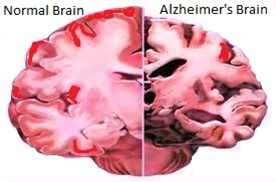Neurological diseases are the diseases of the nervous system and caused due to various factors which includes:
- Lifestyle-related causes
- Genetics and environmental issues.
- Nutritional causes
- Physical injuries
The commonly occurring neurological diseases are:
- Alzheimer’s Disease
- Cerebral Palsy
- Huntington’s Disease
- Multiple Sclerosis
- Parkinson’s Disease
- Stroke
Below is the description of all the disease which will let you understand them in detail.
Alzheimer’s disease
Alzheimer’s disease is a neurological disorder in which the death of brain cells resulting in loss of memory, cognitive impairment and behavioral changes. There are seven stages of Alzheimer’s disease:
- Normal Alzheimer’s
- Normal aged forgetfulness
- Mild cognitive impairment
- Mild Alzheimer’s
- Moderate Alzheimer’s
- Moderately severe Alzheimer’s
- Severe Alzheimer’s
Cerebral Palsy
Cerebral palsy refers to the effects of damage to a developing brain by various causes. The brain damage can occur early at the time of its development or during pregnancy or due to any injury or illness. The four types of cerebral palsy had been identified.
- Spastic cerebral palsy– In this, all the parts of the body gets affected which typically involves muscle tightness.
- Mixed Cerebral Palsy– In this, symptoms of the spastic cerebral palsy combined with the involuntary body movements.
- Dyskinetic cerebral palsy – It causes involuntary movements, changes and also affects posture or movement.
- Ataxic cerebral palsy–This type affects coordination of movements.
Huntington’s Disease
Huntington disease (HD) is an inherited neurodegenerative disease and caused as a result of mutation which may vary from patient to patient and linked to the severity of disease. As the cells begin to die, patients begin to lose control over their body. The disease if not treated properly eventually leads to death after 15 to 25 years from the onset of disease.
Multiple Sclerosis (MS)
Multiple sclerosis is generally referred to as an autoimmune disease or disorder in which the nerve cells of the brain and spinal cord are attacked by patients own immune system resulting in damage due to which the message transmission process gets interrupted. Basically four types of multiple sclerosis namely:
- Relapsing-Remitting (RR) MS – It is the most common type of MS characterized by unexpected appearance and disappearance of the symptoms.
- Primary-Progressive (PP) MS – It is characterized by steady worsening of neurologic functioning.
- Secondary-Progressive (SP) MS – This type is the next level of Relapsing- remitting MS. After a certain period, secondary progressive begins
- Progressive-Relapsing (PR) MS – It is a combination of Primary progressive and relapsing- remitting MS and progress steadily.
Common symptoms of Multiple sclerosis include:
- Tingling and Numbness
- Fatigue and Weakness
- Muscle stiffness or spasms
- Seizures
- Balance Problems and Dizziness
- Breathing problems
- Trouble swallowing
- Bladder, Bowel, and Sexual Dysfunction
- Cognitive Problems
Parkinson’s disease
Parkinson’s disease is a nervous system disorder which is caused due to sudden degeneration of brain areas which manage the actions of our body due to which mechanisms run down, and the signs of Parkinson’s disease begin to emerge. These symptoms incorporate an action, which can be noticed in the hands and arms At times a healthy person develops this disease due to a silent stroke.
Stroke
A stroke is a medical condition which arrives when the blood supply to the brain is interrupted or reduced which leads to cell death. All this can lead to disability, cognitive impairment, brain injury, and in severe case, it leads to death as well. Mainly there are two causes of strokes:
- Ischaemic –In this, presence of blood clot stop the blood supply to brain.
- Haemorrhagic –In this, a brain vessel gets burst which is present in the brain.
There is a condition known as a Transient Ischaemic Attack (TIA), where the supply of blood to the brain is temporarily interrupted which leads to a “mini-stroke”. Treatment of neurological diseases, include the use of anti-inflammatory drugs which only control the symptoms instead of reversing the damage caused to the body due to the disease.
CELL Gen Treatment
CELL Gen stem cell therapy is mainly five step procedures as discussed below:
- Pre-examination – Condition of the disease is examined by few radiological and pathological tests. Based on which further treatment will be decided.
- Sample source extraction – Cell therapy is performed using patients own autologous cells, which begins with sample extraction. Using advanced technologies and globally accepted medical standards, the source extraction is done either from – bone marrow or adipose tissue.
- Lab processing – Once the sample is extracted, it goes under processing, quality testing and quantity of stem cells yielded.
- Stem cell implantation – After retrieving stem cells, they are implanted in to the patient at the area to be treated. For which various techniques are being used based on the disease condition.
- Post treatment care – Usually patients are relieved from the hospital after few hours of the treatment however in certain cases doctor’s observation is required for a day or two.

This is just an nice blog u have. I think I’ll visit your website more if you publish some more of this kind of information. Thanks a lot for publishing this information.
I would like to know if this therapy has any role in PML